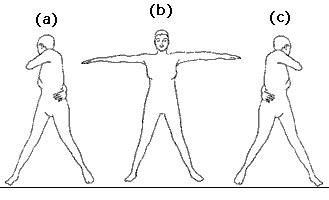Postures to be done for the intestinal wash
Tadasana (The Heavenly Stretch Pose)

This is a slightly different variation of Tadasana to that usually taught. It is not done slowly with concentration on balance but much faster to assist water movement through the abdominal organs.
Stand with the feet together. Interlock the fingers and turn the palms downwards (a). Inhale as you raise the arms up over your head. Slowly rise up on your toes, stretching and lengthening the abdominal area (b). Hold the breath in whilst up in the tip toe stretch for just a few seconds, then exhale as you slowly come down again, resting the hands on the top of your head between rounds (c). Repeat (b) and (c) 7 more times on consecutive breaths with no rest between. All 8 rounds should take no more than about 40 - 60 seconds.
Tiryaka Tadasana (Side Bending Stretch Pose)

Stand with your feet a bit more than shoulder width apart. Interlock your fingers, turning the palms downwards. Inhale as you raise your arms up over your head (a). Exhale as you bend to the right side (b), then inhale as you straighten back up to the centre (a), then exhale as you bend over to the left side (c), then inhale as you straighten back up to the centre position (a). Repeat bending to right and left 7 more times without any break in the breathing. All 8 rounds should take no more than 60 seconds.
Kati Chakrasana (Waist Rotating Pose)

Stand with feet shoulder width apart. Inhale as you raise your arms level to shoulders (a). Keeping the feet flat on the floor, exhale as you twist the upper body to the right side, wrapping the right arm behind the waist and the left hand onto the right shoulder. Turn the head fully to the right to look behind (b). Inhale back to the centre position as in (a). Exhale as you twist to the opposite side (c). Return to the centre position (a). Do 7 more twists to each side, flinging the arm loosely and fast from side to side. All 8 rounds should take no more than 30 seconds.
Tiryaka Bhujangasana (Twisting Cobra)

Lie on the floor on your stomach, forehead on the mat, hands placed under the shoulders, feet shoulder width apart. Have the toes curled under and the heels raised up (a). As you inhale, push up into the cobra pose (b). As you exhale, twist the upper body around to the right, turning the head to look over the shoulder at the left foot (c). Inhale as you come back to the centre position as in (b). Exhale as you twist the body around the left, looking over the left shoulder at the right foot (d). Repeat the right and left twists 7 more times without a break, on the last exhalation, coming down to the starting position (a). All 8 rounds should take no more than 60 seconds.
Udarakarshanasana (The Abdominal Massage Pose)

Squat on both feet, place the hands on knees. Inhale at the centre position (a). Exhale as you twist the upper body and head around to the right, dropping the left knee onto the floor (b). Whilst twisting and holding for a few moments, push the right knee over the left thigh so as to exert a pressure into the lower abdomen. Inhale when coming back into the centre position same as in (a). Exhale as you twist to the left side, pushing the left knee and massaging into the groin area (c). Inhale back to the centre position. Do 7 more twists to each side without a rest. All 8 rounds should take no more than 60 seconds.
For Laghoo, start off with a good pace and keep it that way to the end of the 3rd or 4th round of drinks, but for Poorna Shankaprakshalana, you should pace yourself through the 15 - 30 rounds of exercises you will be doing. For Poorna, do not start like a bull-at-a-gate, but then neither should you start lazily. The best way is to start with the dynamism required for Laghoo until the water breaks through, and then just cruise with a leisurely and consistent pace to the end.
Whether the short or long version, always be sure to breathe properly when performing the Shankaprakshalana exercises. You must not over heat the body, by holding the breath in tension. Use the inhalation of breath to draw in vital energy and use the exhalation to let go of tension along with using the consciousness and the mind to move the water downwards and out.
